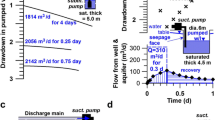Abstract
A mass transport model simulated low-energy groundwater remediation alternatives, including linear arrays of non-pumped wells fitted with filter cartridges and non-pumped arrays augmented with slurry cutoff walls. The nearest component of each configuration was located 5 m from the leading tip of a contaminant plume, and arrays were oriented perpendicular to the regional hydraulic gradient. Results indicate that single arrays consisting only of non-pumped wells allow contaminants to pass between wells and potentially migrate offsite. A second backup array offset from the first array more effectively contains the contaminant plume. Alternatively, a short slurry cutoff wall used in place of wells at the center of an array, along with two backup wells on either side of the wall, also facilitates onsite containment. Such low-energy approaches may be an effective means for containing and removing some contaminant plumes encountered in practice.




Similar content being viewed by others
References
Blowes DW, Ptacek CJ, Benner SG, McRae CWT, Bennett TA, Puls RW (2000) Treatment of inorganic contaminants using permeable reactive barriers. J Contam Hydrol 45(1):123–137
Elder CR, Benson CH, Eykholt GR (2002) Effects of heterogeneity on influent and effluent concentration from horizontal permeable reactive barriers. Water Resour Res 38(8):1152. doi:10.1029/2001WR001259
EPA (US Environmental Protection Agency) (2002) Economic analysis of the implementation of permeable reactive barriers for remediation of contaminated ground water. US Environmental Protection Agency, Washington, DC
Gilbert O, De Pablo J, Cortina J-L, Ayora C, Cama J (2010) In situ removal of arsenic from groundwater by using permeable reactive barriers of organic matter/limestone/zero-valent iron mixtures. Environ Geochem Health 32(4):373–378
Guerin TF, Horner S, McGovern T, Davey B (2002) An application of permeable reactive barrier technology to petroleum hydrocarbon contaminated groundwater. Water Res 36(1):15–24
Gupta N, Fox TC (1999) Hydrogeologic modeling for permeable reactive barriers. J Hazard Mater 68(1):19–39
Hemsi PS, Shackelford CD (2006) An evaluation of the influence of aquifer heterogeneity on permeable reactive barrier design. Water Resour Res 42:W03402. doi:10.1029/2005WR004629
Hudak PF (2007) Mass transport in groundwater near hanging-wall interceptors. J Environ Sci Health 42(3):317–321
Hudak PF (2008a) Evaluation of reactive well networks for remediating heterogeneous aquifers. J Environ Sci Health 43:731–737
Hudak PF (2008b) Configuring passive wells with reactive media for treating contaminated groundwater. Environ Prog 27(2):257–262
Hudak PF (2012) Relative efficiency of multi-transect, non-pumped, reactive well networks for removing contaminated groundwater. Toxic Hazard Subst Environ Eng 47(13):2159–2162
Hudak PF (2014) Comparison of permeable reactive barrier, funnel and gate, non-pumped wells, and low-capacity wells for groundwater remediation. J Environ Sci Health 49(10):1171–1175
Kim G-B (2015) Optimal distribution of groundwater monitoring wells near the river barrages of the 4MRRP using a numerical model and topographic analysis. Environ Earth Sci 73(9):5497–5511
Lai KCK, Lo IMC, Birkelund V, Kjeldsen P (2006) Field monitoring of a permeable reactive barrier for removal of chlorinated organics. J Environ Eng 132(2):199–210
Ludwig RD, McGregor RG, Blowes DW, Benner SG, Mountjoy K (2002) A permeable reactive barrier for treatment of heavy metals. Ground Water 40(1):59–66
Painter BDM (2004) Reactive barriers: hydraulic performance and design enhancements. Ground Water 42(4):609–619
Robertson WD, Blowes DW, Cherry JA (2000) Long-term performance of in situ reactive barriers for nitrate remediation. Ground Water 38(5):689–695
USGS (US Geological Survey) (1999) Deep aquifer remediation tools (DARTs): a new technology for ground-water remediation. US Geological Survey Fact Sheet, Reston, pp 156–199
Zheng C, Wang PP (1999) MT3DMS, a modular three-dimensional multi-species transport model for simulation of advection, dispersion and chemical reactions of contaminants in groundwater systems; documentation and user’s guide. US Army Engineer Research and Development Center Contract Report SERDP, Vicksburg, pp 99–101
Author information
Authors and Affiliations
Corresponding author
Rights and permissions
About this article
Cite this article
Hudak, P.F. Evaluation of non-pumped wells with slurry cutoff walls for containing and removing contaminated groundwater. Environ Earth Sci 75, 67 (2016). https://doi.org/10.1007/s12665-015-4932-3
Received:
Accepted:
Published:
DOI: https://doi.org/10.1007/s12665-015-4932-3




